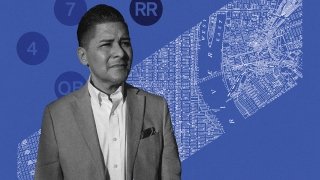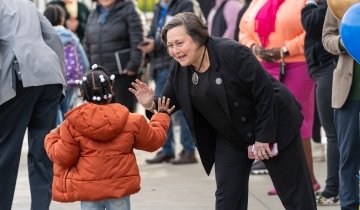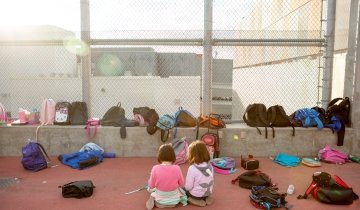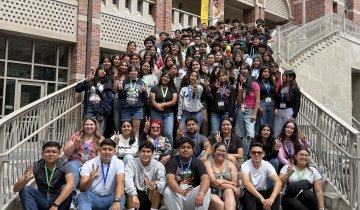The past year and a half has taken its toll on all of us—especially superintendents. There is no step-by-step plan for leading schools through a global pandemic. The stress of the office is immense, and the stakes—keeping millions of schoolchildren safe while ensuring these students have access to a high-quality education—are high. Three superintendents from the largest urban school districts in the U.S. resigned in 2021: Janice Jackson, former chief executive of Chicago Public Schools; Richard Carranza, former chancellor of the New York City Department of Education; and Austin Beutner, former superintendent of Los Angeles Unified School District. While each is moving on to the next chapter of their careers, education—and helping to prepare existing and future leaders—will still be a focus. Here, the three reflect on their time at the helm of the country’s largest urban districts, looking back on their triumphs, the difficulties they faced and the skills they believe today’s education leaders need to succeed.
What do you know now that you wish you had known when you started your position?
Janice Jackson: I had spent the prior three-and-a-half years as [Chicago’s] chief education officer, so I had the privilege of working closely with the superintendent. It’s always different when you’re the principal of an organization, because the stress and the responsibility is obviously greater. I wish I had known about the pandemic—I think everyone feels that way. I didn’t anticipate how politicized people would make a health crisis.
Richard Carranza: I wish I had known just how deeply entrenched the inequity and segregation is in the New York City public school system. It’s almost something people don’t think about. When I first went to New York City, I thought, here’s [this] bastion of liberalism. Surely this progressive city would not stand for this? I wish I would have known how deeply entrenched it is, because we would have had some tactical changes.
Austin Beutner: Many things. There is no substitute for lived experience in almost any leadership position or almost anything you do in life. You can observe a situation, study the data, listen to anecdotes, but the journey of a superintendent in a large urban school district serving predominantly families who are struggling to get by—you have to live it to know it.
What unique challenges do superintendents from large urban districts face?
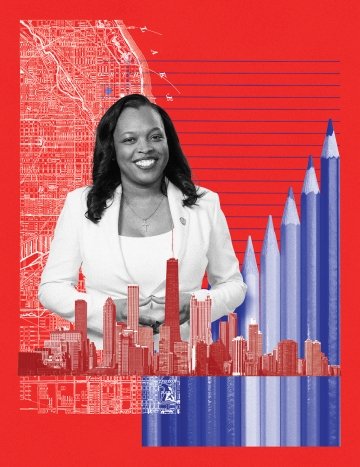
JJ: Superintendents are at the center of everything. I don’t know if people fully appreciated that prior to the pandemic. With the wave of resignations, I’m personally focused on support and advocacy for superintendents. This [wave] is in line with resignations happening across the country, but it’s more concerning in [large urban districts] because the [superintendent] skill set is very specialized.
RC: Many [urban districts] are larger than city municipalities. You have all the challenges that any large municipality would have. You have constituency groups, advocacy groups, your students, their parents. You have unions and union relations. Are buses delivering the children on time? What are students learning? Are the facilities in shape? Those challenges exist in all school systems, but they are heightened in large systems because of the sheer size and the complexity.
There’s about 324 million people living in the U.S. [and] 1.1 million students [are served by] the New York City Department of Education. That means 1-out-of-300 Americans were sitting in one of our classrooms. Couple that with the fact that the budget is $33.5 billion and the 152,000-person workforce—the size and the magnitude of the operation becomes a uniquely challenging issue.
AB: Los Angeles Unified serves the needs of about 650,000, students from families who are struggling to get by. Many of the challenges facing society—poverty and income inequality, lack of access to health care, the digital divide, racial inequities, housing and food insecurity—are the lived experiences of children when they come to school. The job of an urban superintendent is making sure schools provide the best possible education, but it’s also running a health department, running a community support network, running a public safety effort. In Los Angeles Unified, under my auspices and continuing, we’re running the largest COVID-testing program in the nation, the largest food-relief effort in our nation’s history and making sure half a million students have a computer and internet access. A superintendent is the job of someone responsible for schools, wrapped up also with a bit of mayor, a little bit of governor, and a little bit of health department, all into one.
Two other superintendents from the nation’s largest districts also stepped down this year. What particular challenges do you think contributed to these resignations?
JJ: I would characterize myself as someone who can roll with the punches, and COVID packed quite the punch. It’s a combination of a few things. One, the fatigue from the past year. There were a few key people in school systems who worked throughout this pandemic. Superintendents, nutrition-support staff and many of our school leaders, for the most part, reported to buildings. Anyone who actively showed up to a building during this pandemic, that took a lot out of them. A lot of people had to reflect on whether they have the gas to do what’s needed to recover. I’ve been with Chicago Public Schools my entire life, so I also hope that people see the totality of service. We’ve been through a lot: multiple strikes, a financial crisis, a sex-abuse scandal. I’ve been privileged to be in this role. I felt like it was time to hand it over to someone else, and I would imagine a lot of people who made similar decisions felt that way.
“Being a champion for equity in its truest form means you have to disrupt systems and practices.” —Janice Jackson, former chief executive officer of Chicago Public Schools
RC: Anybody in a leadership position got the snot beat out of them this last year and a half. There was a lot of conflicting and even contradictory guidance from the federal and local governments. State and local municipalities were caught in the middle. We’re superintendents. None of us went to school to be virologists, epidemiologists or subject-matter experts in personal protective equipment. All of us were thrust into these very difficult situations with constituents. Some wanted us to open quicker than we did; some don’t want us to open until this virus is eradicated. People in positions of authority were just trying to do the right thing, [and] in many cases, without sufficient guidance.
AB: It is a demanding job, no question about it. I was granted emergency authority early on, so I was the face not only the face of the organization, but responsible for what we did—no passing the buck. The work schedule was 6 in the morning to 9 o’clock at night, seven days a week. There were protests from people who did want to be vaccinated and those who didn’t want to be vaccinated. You’re in the crucible. But I am proud of what my 86,000 colleagues and I accomplished. I think we led the nation in many respects.
As we emerge from the pandemic what new skills and tools do today’s education leaders need to succeed?
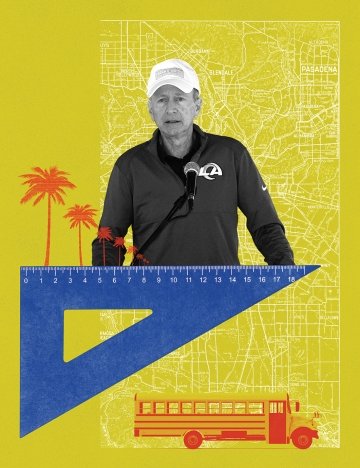
JJ: Crisis management. And you definitely have to be savvier and more skilled in communications (p. 37). Preparation programs should be paying attention to those two areas, particularly in regard to racial justice. Some have been fearful about how to respond. In Chicago, you can talk about equity—we’ve been teaching racial justice and talking about Freddie Gray and reparations for people who have been brutalized by the police here in Chicago because of the history we have. We live in a space where we can speak openly about those things, which, honestly, is only phase one of doing something about it. For other superintendents, it’s a delicate balance.
And, of course, union relations. Big unions in major cities have gone beyond bread-and-butter issues to negotiate [for] quality-of-life indicators and policies, which obviously are important and make our communities better. I think they’re inappropriate to bring into discussions as you’re negotiating public education. If I’m being honest, that only happens in large urban school systems. People wouldn’t stand for that in affluent, White districts.
RC: We faced three pandemics: COVID-19, the economic pandemic and then the social-justice and racial-equity reckoning. We cannot go to back to normal. Normal never served all children. The new normal is going to be characterized by meeting the individual needs of students. We’ve decried the technological divide for decades, [but the pandemic] forced us to reckon with [it]. School districts have invested hundreds of millions of dollars in getting devices to students. Teachers now have the opportunity to use technology to truly individualize what students need to learn. I would never advocate for replacing caring, well-trained teachers in front of students, but the ability to individualize is more relevant and prevalent than it’s ever been in my 30 years as an educator.
If you look at the three largest school systems in America—New York, Los Angeles and Chicago—and you overlay where historically underserved communities are in each of our cities, and then you overlay which communities were the hardest hit by the pandemic, they align perfectly. People can’t deny the inequity. Investing in historically underserved communities is something [we] have to do because we’ve seen the results of not having done that. It’s going to be important for leaders to be cognizant that the trauma these communities have faced is real, and it’s not going away. Future leaders are going to have to be resolute about calling out equity issues. They’re going to have to have tough skin. I can tell you firsthand, when you start pointing this out and start moving resources and dismantling systems that are oppressing children, people will come out of the woodwork to keep the status quo.
AB: Our leadership team talked a lot about how we need to take a COVID mindset to everything we do. The emergency authority that I was granted allowed us to act quickly. One example is Primary Promise, a program we launched to help elementary school children build foundational literacy, math and critical thinking skills. At most urban school districts, roughly half of kids are at grade level and half aren’t. If you can make a difference in early reading, you’re going to see dramatically better life outcomes for children.
In January 2020, we announced an effort to do something different, with Dean Pedro Noguera when he was still at UCLA. We said, let’s put a reading specialist into each classroom. When COVID came, we expanded the effort tenfold as we knew students just learning to read would be among those most impacted. We used the extraordinary [COVID] resources the federal government provided to be able to do it. Our first cohort in August 2020 was 2,500 first graders. Of the 2,500 kids, 9 percent were proficient at the start of the school year; by midyear, 42 percent. Big gains continued through the school year, so we expanded to 6,700 K–3 students. This year, it’ll be 14,000 students. The groups that showed the most dramatic increases are Black students and English learners, ahead of their peers.
If we are providing our Black students with a foundation in literacy, math and critical thinking skills at a young age, that is an important start of what racial equity looks like in a school.
The future of Los Angeles is in our public schools today, and the community better recognize that.” —Austin Beutner, former superintendent of Los Angeles Unified School District
What do you consider your greatest accomplishment in the role?
JJ: The creation of the equity office and the equity work that we’ve done in Chicago not only has benefited our district, but it has served as a national model. There have been a few major initiatives that impact the entire district: our universal enrollment plan, which created greater access and equity to programming across the city, and Skyline, our pre-K–12 curriculum.
There are so many indicators pointing in the right direction: increases in graduation rates, test scores, college enrollment and college graduation. These are not isolated areas of success. What that says is that it is possible. It lays the foundation for the next generation of leaders and educators to take it to the next level.
RC: I don’t think my colleagues in New York City had ever heard a chancellor [be] so plainspoken about the inequity that exists in our system. I think that empowered individuals who felt the same way to be OK in saying there is structural and institutional racism that disenfranchises large swaths of our student body, and it’s not in line with our best thinking. In the future, it’s going to be impossible for any mayor, city councilperson or assembly member not to have a position on the inequity and segregation of the city. I’m proud that I raised that issue and didn’t back off, even under withering attack.
The other thing I’m really proud of is that New York has had a long tradition of being a decentralized system. At 1,800 schools, you had 500 curriculums. [Now], we have three or four, and it allows us to maximize our instruction and professional learning. We’re not trying to put everybody on the same page on the same day at the same hour, but this is really what’s good for kids.
AB: We have gone a fair way towards restoring confidence in public schools in Los Angeles. We did a bunch of surveys [addressing] not only our COVID response, but what people thought of schools more broadly. [Around] three-quarters thought we’re doing the right thing. That’s an extraordinary change.
We provided meals, COVID tests and vaccinations, computers and internet access. We kept people safe. We upgraded the air-filtration systems. We delivered on the promise. That leads to something which will bear more fruit down the road, bringing everyone in Los Angeles into the conversation about public education. We brought community partners into schools and set up a not-for-profit to support our relief efforts, which raised over $40 million. The future of Los Angeles is in our public schools today, and the community better recognize that.
What was your greatest challenge?
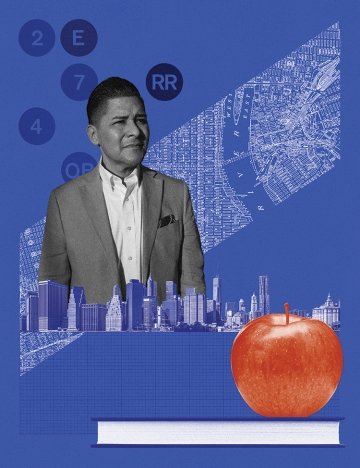
JJ: When you do this work—even if you do it well—you expend a lot of energy, resources and other capital to get it done, [yet] sometimes we can feel like there’s still so much more work to do. That spirit of continuous improvement and being able to push for higher expectations, but also taking stock of the progress that has been made, was always a delicate dance. It’s critical to make people feel like the work is worthwhile. I know [Chicago Public Schools] is in a better place as a result of my leadership, but I can’t help but think we could have done more.
RC: One of the big challenges in New York City was this perception for people that didn’t like what I was saying, because it has mayoral control [and] when a new mayor comes, there’s probably a new chancellor. So [they think], let’s wait this guy out. One challenge was making headway while “the lifers” wait you out.
AB: Convincing the haves, the cynics, the skeptics and people who care but have given up hope that we can do better and that we all have a stake in the success of kids in public schools.
How would you describe your leadership style?
JJ: I am extremely serious about the work, and I have an unrelenting focus on students. I believe in shared leadership, collective impact and responsibility. But I do believe once the decision is made that people must implement it with fidelity. The trade-off is allowing for diverse ideas, multiple viewpoints and engaging as many people as possible in the decision-making process. You can have 10 people doing great work, but you’re not going to get the same impact that you will get if you have 10 people all working on a common mission with common language and practices.
RC: I’m inclusive and participatory. I’m unapologetic in terms of what we stand for, and we stand for kids—all kids. I’m not a micromanager, but I set a vision and expect everybody on the team to be moving towards that vision.
“Normal never served all children. The new normal is going to be characterized by meeting the individual needs of students.” —Richard Carranza, former chancellor of New York City Schools
AB: Inclusive. I’m a good listener. There’s a multiplier where you bring others in, and one and one becomes five. Whether it’s bringing in Microsoft, Johns Hopkins or UCLA to help us think about our COVID challenges or gathering internal folks to look at the challenge of early literacy. I’m a fan of the Socrates approach—the responsibility of a leader is to ask questions, to get to the root cause of a problem and find the best solution.
What advice do you give to your successor?
JJ: Keep student needs at the center. Being a champion for equity in its truest form means you have to disrupt systems and practices, even [those] that seem [they’re] the right thing to do, because we’ve always done it [that way]. Principal leadership is critically important, especially in large school systems. Good principals hire the right folks in schools and create the right conditions.
RC: Before I left, I said [to my successor], do you. Don’t apologize or take responsibility for any mistakes that I may have made. But then again, don’t try to be me—be you. And be very cognizant that there are a lot of constituencies, and the more you engage with all constituencies, the better.
AB: Start with the kids and families. If it’s right for the kids, then find a way to make it happen. In public education, [the majority] of public comment and the newspaper articles I read don’t start with [what’s] in the best interest of children.
What’s next for you?
JJ: I am leading a new non-profit called Hope Chicago. The mission is to create pathways to success for multiple generations of Chicagoans through equitable access to higher education by offering students and their parents scholarships, and wrap-around services to go to college or a professional trade program.
RC: I’m chief of strategy and global development at IXL Learning. There are various facets to my role. One is working on strategy for growing the business in the United States but also internationally—Latin America, in particular. My other role is kind of “superintendent in residence”: What would I want to see? What would add value to a school system? The third role is being the prognosticator: Where are we going in the future?
AB: I will keep trying to find a way to make a difference for others. I didn’t take the traditional path to become superintendent. I’ve had many chapters in my life and there will be another. Most immediately, I’m focused on a not-for-profit I started called Vision To Learn, which provides free eyeglasses to children at schools in low-income communities. It’s now in more than 500 cities across the country, from Hollywood to Baltimore.

